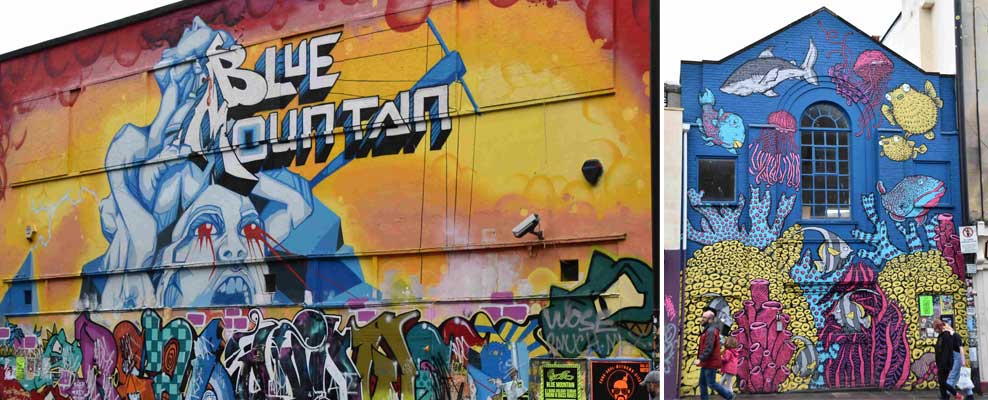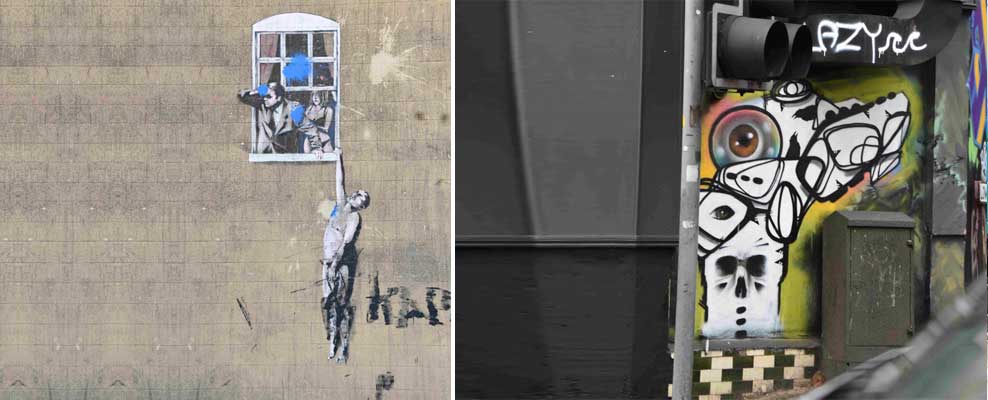It may require a fair bit of exercise for your pupils but you must keep your eyes peeled in all directions because it erupts without any warning: Staring off a bridge, peering down from a balcony, gazing from the ground at the car park, up on a high wall, in a shady alley or on a bustling street. No matter where you look, there is an explosion of colors taking on forms of letters, beasts, people; it’s almost as though row upon row of art galleries have knocked down their roofs and walls to reveal their prized exhibits under the open sky. As you gasp and grin, awestruck and amazed by the mindboggling diversity of style and subjects, you realize that Bristol, a maritime town just over a hundred miles from London, is being hailed as the Mecca of street art for a jolly good reason.

Like Berlin and Sao Paulo, New York and Santiago, Bristol has been attracting street art connoisseurs from all over the world to its al fresco galleries. What was once dismissed as vandalism—from graffiti voicing protests to murals displaying social and political satire—now finds itself listed in the realm of bonafide art. Often subversive, mostly satirical, and always organic, street art has become Bristol’s claim to fame. Some go so far as to claim that it is the birthplace of street art in the UK. And as if to underline its numero uno status, Bristol holds Upfest, Europe’s biggest street art festival, and See No Evil, UK’s largest permanent street art project.
Banksy is the one credited with making Bristol what it is: The street art capital of the world. The elusive artist − no one knows just who he is as he painstakingly keeps his identity under wraps − grew from being a kid playing cat-and-mouse with the police for illegally desecrating Bristol walls with his spray-paint to featuring in Time magazine’s list of 100 Most Influential People in 2010. He is, in fact, so popular that when he held a “homecoming” exhibition in the Bristol City Museum in 2009, crowds queued up for hours for a glimpse. Some of Banksy’s earlier works have been accidentally painted over but those with a keen sense of history and art rush to see the ones that remain.

Even though every part of the seaside town boasts of at least one landmark mural, if you want street art in a more concentrated form − or want your money’s worth in a quick jiffy − head to edgy Stokes Croft, the town’s quirky cultural quarter. For, it is here that the most arresting and dynamic array of street art is on display. From the venerated Banksy who has an oeuvre that is globally recognized, cherished, and deservedly bought for obscene amounts of money, to artists like Stinkfish, Nick Walker, Inkie, Pixel Pancho, and Sepr, all have contributed to the riot of colors in the area.
Stokes Croft itself has a story worth narrating. Once gritty and neglected, it was seen as infra dig and unsafe, a haven of criminal activities. Riding on the back of the street art scene − and some positive radical activism from the likes of People’s Republic of Stokes Croft, a community organization that works to promote civil liberty in public spaces − it transformed into a hip neighborhood. Now an entire street art gallery has sprung up, thanks to the efforts of PRSC that aims to visually and artistically improve the area and create a sense of identity. But even though street art remains Stokes Croft’s calling card, it has an enviable social scene too with a string of groovy clubs, pubs and restaurants and a bohemian vibe.

For street art, it has been a long journey. Graffiti, once a form of vandalism and a punishable offence, has now become a legit art form. But it’s all mostly ephemeral − here today, gone tomorrow. Just like life. Perhaps that’s why they say that art imitates life. Or should it be the other way round?
(Several groups, like WhereTheWall, organize walking tours of Bristol’s street art.)
